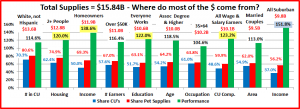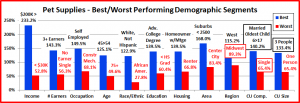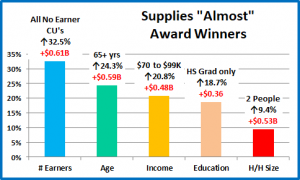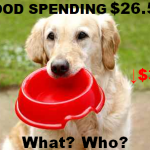2016 Pet Supplies Spending was $15.84B- Where did it come from…?
Next we’ll turn our attention to Pets and Supplies. We’ll see some differences from Pet Food as the spending in the Supplies segment is much more discretionary in nature. There are other factors too. Many product categories have become commoditized so pricing changes (CPI) can strongly impact Consumers’ buying behavior in this segment. Supplies’ Spending is also affected by the spending behavior in other segments. In 2015 Consumers spent $5.4B more on Pet Food. They helped pay for this by spending $2.1B less on supplies, primarily by purchasing 10% less frequently. In 2016, things turned around as Consumers value shopped for premium foods but spent $0.94B more on Supplies. This “lift” didn’t get the segment back to the $17B spent in 2014 but it was a good start in getting Supplies back on track.
Let’s see which groups were most responsible for the bulk of Pet Supplies spending in 2016 and the $0.94B lift. The first chart details the biggest pet supplies spenders for each of 10 demographic categories. It shows their share of CU’s, share of pet products spending and their spending performance (Share of spending/share of CU’s). Although their share of the Pet Supplies $ may be different from their share of the Total Pet $ or Food, all of the big spending groups are the same. The categories are presented in the order that reflects their share of Total Pet Spending. This highlights the differences in importance. In Pet Supplies spending, Homeowners have the lowest market share for any industry segment. However, the share of spending for Suburbanites is larger than for Food. All Pet Parents need supplies, regardless of their housing arrangement. However, if you have more space you have room for more supplies. Income is still the highest performing demographic characteristic and we’re back to 5 groups performing above 120%. Pet Food had only 4 as Education dropped out. Increased Education correlates with increased income and income is more important in supplies spending.
- Race/Ethnic – White, not Hispanic (85.5%) This large group accounts for the vast majority of spending in every segment. With a 122.9% performance rating, this category ranks #3 in terms of importance in Pet Food Spending demographic characteristics. While Hispanics, African Americans and Asian American account for over 30% of U.S. CU’s, they only spend 14% of Pet Supplies $. Pet ownership is relatively high in Hispanic American households. However, it is significantly lower for African Americans and Asian Americans which is reflected in Supplies spending.
- # in CU – 2+ people (81.2%) The share of market for 2+ CU’s is very close for all segments. Their overall Supplies performance of 114.6.1% is relatively high because singles perform so poorly. Although performance peaks in 3 People CU’s, it still remains relatively high in larger CU’s. It only falls below 100% in 5+ people CU’s and even then, it is 97.4%. In Supplies’ Spending, it definitely “just takes two.”
- Housing – Homeowners (74.9%) Homeownership is a major factor in pet ownership and spending in all industry segments. However, with 120.0% performance, homeownership is in 5th place in terms of importance for increased pet Supplies spending. The Homeowners’ share of market fell only slightly from 75.4% in 2015. Although all segments in this category registered spending gains in Supplies in 2016, Renters gained a little ground as they had a slightly bigger percentage increase than all Homeowners.
- Income – Over $50K (69.3%) With a performance rating of 138.6%, CU income is the single most important factor in increased Pet Supplies Spending. The increased discretionary nature of much of Supplies spending pushes the performance level slightly higher than that of Pet Food. However, it is still significantly below the Service Segments. Although they are not as pronounced as in the Food segment, we still have the same anomalies of retired Americans spending more on their pets than their income would suggest and the higher income, Asian Americans spending much less. However, Higher Income still generally generates Higher Pet Supplies Spending.
- # Earners – “Everyone Works” (67.0%) In this group, all adults in the CU are employed. This group’s high share of Pet Supplies $ reinforces the importance of income in Supplies spending. Their performance is 116.4%, which is higher than Food but doesn’t reach the 120% level. In this case, it shows that CU’s with 2+ people and only one earner, along with retired people, still spend a lot of money on Supplies – 33% of Total $.
- Age – 35>64 (64.2%) Traditionally Supplies Spending skews more towards the younger groups. The 35>64 group repeated their dominance from last year with a slightly higher market share, up from 62.3% in 2015. Their 118.5% performance level also improved from 114.6% and is approaching the 120% level. There was some turmoil in the category as the 25>34 age group cut back on Supplies to help “pay” for increased spending on Pet Food. However, the 65+ year olds stepped up their Supplies spending, which more than made up the difference.
- Occupation – All Wage & Salary Earners (63.8%) – The market share and performance of this group, 104.6%, are very similar to those for food. The spending is definitely skewed towards the higher income, white collar workers. Also, the low performance shows that a lot of spending is being done by the Self-employed and retired groups.
- Education – Associates Degree or Higher (63.1%) Income generally increases with education. We see the effect of this with a larger market share for this group than in Food and a radically improved performance level of 122.0%. This makes higher education the 4th most important factor in generating greater Supplies
- Area – Suburban (62.0%) Suburban CU’s are the biggest spenders in every segment. The fairly high performance of 113.0% reflects the lower share of Supplies $ in Central Cities and the truly Rural areas.
- CU Composition – Married Couples (59.9%) Married couples are a big share of $ and have 120+% performance in all segments. Their performance of 123.2% puts them in 2nd place in terms of importance to Supplies spending.
The biggest spending groups for Pet Supplies are the same as those for Total Pet and Pet Food. However, the discretionary nature of Supplies causes spending to be more impacted by income than Food. Groups associated with higher income, like Education and # Earners, have higher performance than in Food. The numbers are actually close to those of Total Pet. Supplies also has 5 groups performing above 120%, which shows greater disparity between segments.
Now, we’ll look at 2016’s best and worst performing Pet Supplies spending segments in each category.
As usual, most of the best and worst performers are those that we would expect. In Pet Supplies spending, there are only 4 that are different from 2015. That is less change than the 6 in Pet Food but it is still 1 more than for Total Pet. As we move deeper into the data, we will start to see even more differences between the Industry Segments. Changes from 2015 are “boxed”. We should note:
- Income matters and is growing even more important. The 233.3% Performance by the $200K> group is 23.9% better than their performance in Food and 8.9% higher than last year.
- Of Note: 8 of the 11 winners for best performance had the highest income of any segment in the category and the other 3 – White, not Hispanics, Suburbs <2500 population and 3 people Cu’s, were all second in income.
- CU Composition – This year’s winner is Married Couples with the oldest child between 6 and 17. This reflects the strong performance by the 45>54 age group as well as the improved performance of the 35>44 group. Both are almost all Gen Xers. This year’s lowest performer was singles. Last year it was single parents. Quite frankly, every year these two groups are invariably at or near the bottom in performance.
- # in CU –In 2015 there was a virtual tie in performance for all CU’s of 2 or more people. 2016 was different in that only 2 or 3 people CU’s had performance over 100% and the 3 people group finished on top. Singles are perennially the worst performers.
- Region – In 2015 the Midwest finished second with 103.6%. In 2016, they were the only Region with a decrease in $.
It’s time to “Show you the money”. Here are segments with the biggest $ changes in Pet Supplies Spending.
2016 was up $0.94B after a $2.1B drop in 2015 so there were a lot of changes. There are 2 repeat winners and 3 repeat losers. In 3 categories, last year’s loser was this year’s winner. In 1 category the winner and loser from 2015 switched positions. Retired persons were a surprise winner but the big news came from the Housing category where all segments had an increase. This occurred only one other time in 2016 – in Services: Racial/Ethnic Ctgy . Here are the specifics:
- Area Type – Central Cities has two consecutive years of increases totaling $1.36B
- Winner – Central City – Supplies Spending: $4.84B; Up $0.92B (+23.4%)
- 2015: Central City
- Loser – Suburbs >2500 – Supplies Spending: $7.07B; Down $0.4B (-5.3%)
- 2015: Rural
- Comment – The larger Suburbs have the largest share of Supplies $, but they are now down $1.18B since 2014.
- Winner – Central City – Supplies Spending: $4.84B; Up $0.92B (+23.4%)
- Race/Ethnic – The White, Non-Hispanics share of Supplies spending is 85.8%. In 2015 they were down $2B.
- Winner – White, Not Hispanic – Supplies: $13.58B; Up $0.81B (+6.3%)
- 2015: Hispanic
- Loser – Hispanic – Supplies: $1.34B; Down $0.003B (-0.2%)
- 2015: White, Not Hispanic
- Comment – Only Hispanics had increased Supplies spending in 2015. In 2016, they were the only group that spent less but it was a very small decrease – only $3M. The biggest concern is that the White, Non-Hispanic group is still down $1.2B from 2014.
- Winner – White, Not Hispanic – Supplies: $13.58B; Up $0.81B (+6.3%)
- Age – In 2015, all age groups spent less on Supplies. In 2016 only 2 groups spent less – 25>34 and 55>64.
- Winner – 35>44 yrs – Supplies Spending: $3.13B; Up $0.69B (+28.1%)
- 2015: <25 yrs
- Loser – 25>34 yrs – Supplies Spending: $2.11B; Down $0.56B (-21.0%)
- 2015: 45>54 yrs
- Comment: The 35>44 Gen Xers had the biggest increase while the 25>34 Millennials registered the only significant decrease. They spent a lot more on food so they cut back on supplies. Perhaps the biggest surprise was the $0.59B increase from the over 65 group.
- Winner – 35>44 yrs – Supplies Spending: $3.13B; Up $0.69B (+28.1%)
- Occupation – In 2015, all but 1 group – Mgrs/Prof., spent less. In 2016, all but 1 group – self-employed, spent more.
- Winner – Retired– Supplies Spending: $2.57B; Up $0.63B (+32.1%)
- 2015: Mgrs. & Professionals
- Loser – Self-employed– Supplies Spending: $1.50B; Down $0.22B (-12.7%)
- 2015: Retired
- Comment – The Retired group had a huge turnaround from down $0.35B in 2015 to up $0.63B in 2016. Unfortunately, they “paid” for it with a $1.35B decrease in Food spending. Perhaps, the best news was that every wage or salary earning occupation had an increase. This showed that the increase was very widespread.
- Winner – Retired– Supplies Spending: $2.57B; Up $0.63B (+32.1%)
- Income – In 2016, three income groups spent less on Supplies but that is better than 2015 when every group was down.
- Winner – $200K> – Supplies Spending: $2.08B; Up $0.59B (+39.6%)
- 2015: $100 to $149K
- Loser – $150 to $199K – Supplies Spending: $1.25B; Down $0.31B (-20.1%)
- 2015: $70 to $99K
- Comment – The winner is no surprise. The surprise is that the combined $100>199K group was down $0.61B
- Winner – $200K> – Supplies Spending: $2.08B; Up $0.59B (+39.6%)
- Region – The Northeast is a bit of a surprise. Their strong showing was driven by the Central Cities.
- Winner – Northeast – Supplies Spending: $2.97B; Up $0.59B (+24.7%)
- 2015: West
- Loser – Midwest – Supplies Spending: $3.03B; Down $0.3B (-8.9%)
- 2015: Midwest
- Comment – The Midwest is down $1.7B (-36%) since 2014. They have fallen from best to worst in performance.
- Winner – Northeast – Supplies Spending: $2.97B; Up $0.59B (+24.7%)
- # in CU – It’s simple. 2 and 3 people CU’s had the biggest increases with 3 people winning by only $0.02B.
- Winner – 3 People – Supplies Spending: $3.12B; Up $0.55B (+21.4%)
- 2015: 1 Person
- Loser – 5+ People – Supplies Spending: $1.47B; Down $0.15B (-9.5%)
- 2015: 5+ People
- Comment: In 2015, singles were flat in spending while all other sizes spent less. In 2016, CU sizes from 1 to 3 people all posted increased Supplies spending while the CU’s with 4 or more people spent less.
- Winner – 3 People – Supplies Spending: $3.12B; Up $0.55B (+21.4%)
- CU Composition – The winner correlates with the lift in spending from the 35>44 age group.
- Winner – Married, Oldest child 6>17 – Supplies: $2.58B; Up $0.55B (+27.2%)
- 2015: Unmarried, 2+ Adults
- Loser – Married, Child >18 – Supplies: $1.48B; Down $0.13B (-8.2%)
- 2015: Married, oldest child >18
- Comment – Only Married Couples with an oldest child under 6 or over 18 and single parents spent less on supplies in 2016. All other CU composition segments spent more.
- Winner – Married, Oldest child 6>17 – Supplies: $2.58B; Up $0.55B (+27.2%)
- Housing – All Housing segments spent more on Supplies in 2016.
- Winner – Homeowner w/o Mtge – Supplies: $3.96B; Up $0.53B (+15.5%)
- 2015: Renter
- Loser – Homeowner w/Mtge – Supplies: $7.9B; Up $0.1B (+1.3%)
- 2015: Homeowner w/o Mtge
- Comment – With the Homeowners without a mortgage, we have another last to first position switch. Much of this segment’s spending was driven by the retired group.
- Winner – Homeowner w/o Mtge – Supplies: $3.96B; Up $0.53B (+15.5%)
- Education – A big change from last year when all education levels had reduced spending.
- Winner – Adv. College Degree – Supplies Spending: $3.71B; Up $0.52B (+16.4%)
- 2015: All College Grads
- Loser – <High School Grad – Supplies Spending: $0.66B; Down $0.17B (-20.6%)
- 2015: HS Grad or less
- Comment – The Advanced Degree group spends the most per CU and had the biggest increase. Only those without a High School diploma and strangely, those with a BA/BS, spent less on Supplies.
- Winner – Adv. College Degree – Supplies Spending: $3.71B; Up $0.52B (+16.4%)
- # Earners – In 2016 the “unlucky” number was 1. Only 1 earner CU’s, regardless of size, spent less on Supplies.
- Winner – 2 Earners – Supplies Spending: $6.72B; Up $0.51B (+8.2%)
- 2015: 2 Earners
- Loser – 1 Earner, Single – Supplies Spending: $1.91B; Down $0.16B (-7.7%)
- 2015: 2+ in CU with 1 Earner
- Comment – Income is a factor, especially when discretionary spending produces financial pressures. 2 and 3 Earner CU’s spent substantially more as did the retired, No Earner CU’s. A 1 Earner CU has had the biggest decrease for 2 consecutive years.
- Winner – 2 Earners – Supplies Spending: $6.72B; Up $0.51B (+8.2%)
We’ve now seen the winners and losers in terms of increase/decrease in Pet Supplies Spending $ for 11 Demographic Categories. Overall, 2016 was a year of moderate changes. The winning increase in each category was generally around $0.5B while the biggest decrease was usually in the $0.2 to $0.3B range. We saw strong contributions both from the Gen Xers and the over 65 age group. While the $0.94B increase did not gain back the $2.1B spending drop in 2015, it’s a good start. As we have noted before, not every good performer can be “the” winner and some of these “hidden” segments should be recognized for their outstanding performance. They don’t win an award but they deserve…
Honorable Mention
Pet Supplies spending was up $0.94B in 2016. While the increase was not huge, it was relatively demographically widespread as 53 of 82 segments (64.6%) spent more on Supplies. The “almost” winners in the chart reinforce the performance of both the older, retired Americans and the middle income group. We also see that you don’t have to have a College degree to buy Pet Supplies. These 5 segments didn’t win any awards but their combined Supplies spending increase totaled $2.57B. They made a difference.
Summary
In 2015 and 2016 we saw how significant changes in spending behavior in one Industry segment can impact the other segments. In 2015 a large group of consumers upgraded their Pet Food to Super Premium and spending took off – up $5.4B. However, in order to help pay for the upgrade, they cut their spending on Supplies (-$2.1B) and Veterinary ($0.5B). The $2.1B decrease resulted in a spending drop in Supplies in 74 of 82 Demographic segments (90%). It was pervasive. However, 2016 brought another change. Consumers began seriously price shopping for their high end Food, at retail and on the internet. They managed to save $2.99B and they used some of this savings to spend $0.94B more on Supplies and $1B more on Veterinary Services. Supplies didn’t come all the way back but it was a good start as almost 2/3 of the demographic segments increased spending in 2016.
Pet Supplies spending is more discretionary than Food but there are still many categories which are real needs for Pet Parents – dog collars and leads, cat litter, feeding bowls and even dog toys and chews, to name a few. Other categories like carriers, clothing and flea & tick items also become real needs under certain circumstances. The big difference between the Supply needs and Food needs is frequency of purchase. Overall, Pet Supplies are purchased less often than Pet Food and Treats but much more often than either of the Service Segments.
Although it is not an absolute necessity like Food, the spending behavior on Pet Supplies can also be a reflection of the percentage of pet ownership across a demographic category. The performance of the bulk of the spenders is also very important. We identified four demographic categories with high performing large groups. (There were 3 for Pet Food)
- Income
- Higher Education
- Homeownership
- CU Composition
Increased income, higher education, homeownership and being married all generate increased pet supplies spending and all are categories in which the consumer can exercise some degree of control. The disparity in performance of segments within these categories allows industry participants to more effectively target both their best customers as well as those most in need of improvement.
The Value shopping for Food caused considerable turmoil in that segment. The bounce back in Supplies was a little calmer and more evenly dispersed. There were only 4 changes in the best and worst performing individual segments. As usual the biggest changes showed up in $. There were some surprising winners, like the Northeast, Central Cities and Retirees. There were also 2 major trends of note:
- The Age “split” – The biggest increases came from the 35>44 and the over 65 age groups.
- The U.S. continues to Urbanize and our Pets are coming with us. Rent…Own… All Housing options work for pets.
Finally – The “Ultimate” Pet Supplies Spending Consumer Unit consists of 3 people – a married couple, with their 17 year old child. They are in the 45 to 54 age range. They are White, but not of Hispanic origin. At least one of them has an advanced College Degree. Both of them work, running their own business and their child just started a part time, after school job. They’re doing well with an income over $200K. They still live in a small suburb, adjacent to a big city in the Western U.S. and are still paying off the mortgage.







